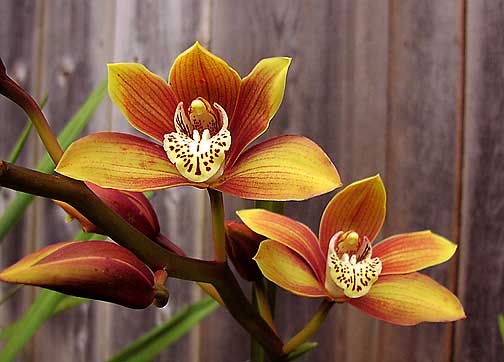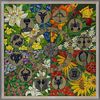Flower EncyclopediaENTER THE WORLD OF FLOWERS |
Other News
Cymbidium
Category: Orchids and Bromelievi
21 Mar : 14:38
To view pictures click on them









 From tsimbidiuma at room conditions using only a "minuscule" hybrids, because in these wild orchids reached significant proportions. "Miniature" varieties do not actually have small, often reaching up to 1 m in height.
From tsimbidiuma at room conditions using only a "minuscule" hybrids, because in these wild orchids reached significant proportions. "Miniature" varieties do not actually have small, often reaching up to 1 m in height.Representatives of this genus are found in India, Burma, Japan, Australia and Asia Yugoztochna.
Tsimbidium hybrid is the main species cultivated indoors. Known are dozens of varieties resulting from the hybridization.
In China, tsimbidiumite are known and honored before the foundation of western tsivilizatsiya.V Chinese history, tsimbidiumat remained a symbol of grace and friendship, famous for its beauty and wonderful aromat.Za Konfutsii even write it, 500g.pr.n.e . He was the first called him in his manuscript "king of spices" - nicknamed by tsimbidiumat which is known today. Still argue whether today resemble the ancient species.
CHINESE TSIMBIDIUMI are subgenus - Cymbidium Jensoa and include 5 types - gorengii, kanran, ensifolium, sinense and faberi. In some texts call them "Asian" other "Chinese", in fact it is a common plant in China, Taiwan, Japan and parts of Thailand and Vietnam.
There is almost complete divergence between Asian and European classification. Some species have up to 30 different names. To orient ourselves in this mess of terms and names should be acquainted with the structure of the plant.
In tsimbidiuma, each has its own root psevdobulba sistema.Psevdobulbite are "skaldovata base for water and spare food. They are small and therefore tsimbidiumite need more frequent watering than with other avid collectors orhidei.Za, the leaves are even more important than tsvetovete.Te differ in their width and dalzhina.Pochti all types are flat and only a few Agents are oval - "Tu Er Lan" (orchid "rabbit ears"). Other variations are wavy or spiral wrapping the leaves. Most valuable for collectors is the presence of pattern on the leaves. Pastrolistite species differ in the type of pattern and the exact shades of colors.
The colors of the Chinese species are smaller plants also tend to be more compact, has a great variety of colors: almost black, white, red, yellow, is valued as "pure" colors without sharki.Pochti always with a strong aroma. Some species bloom in LYaTOTO.Ne is rare and several flowering within a year.
Classical hybrids are divided into two groups, standard and miniature sortove.Tezi two groups have similar requirements for otglezhdane.Te withstand lower temperatures and more drought than the Chinese species, but at the expense of flower it more difficult . For these types of leaves have decorative effect, the colors are great, but without flavor.
Flowering period lasts for 2 months.
Even being cut, the colors retain their beauty for several weeks.
After flowering flowering stems should be removed. Beautiful leaves make a very decorative plant, even when there are no colors.
Irrigation: The basic rule is to not allow to dry. Water for 10-14 days in winter when tempetaturite are lower and twice weekly during the hot summer days.
Temperature: They need 20-25 ° during the day and 10 ° below the temperature at night. Provide 15-16 ° at night by increasing air circulation and humidity.
Light: This is one of the main factors for the proper development of tsimbidiumite. If the light is small, the plant will be less susceptible to diseases and pests will flourish. If the light is too strong, the leaves will burn and will be lost decorative effects (especially in pastrolistite species).
In the home are kept in a colored shadow, guided by the color of the leaves - should be deep green. For amateurs, it is recommended to be grown year round and the window should not be subtracted out, the risk of overheating and burning leaves.
Replanting: Every 2 to 3 years before the bark, which is useful to break. The most appropriate time for this spring, after flowering. Replanting carefully blend at medium large by providing adequate ventilation and provided space for 2 year sprouts. Use a loose mixture of large, medium pine bark, coarse peat and perlite. After paying the roots carefully, place in a pot so that novoizrastvashtite psevdolukovitsi are far from the edge, fill the mixture and gently press with.
It is extremely important when transplanting is not wrapped base of the stem, but leave it above the surface of the substrate.
This is the most beautiful orchid!
Category: Orchids and Bromelievi
Comments are turned off for this item0
| wild orchids rabbit ears shades of colors ancient species china taiwan |
You must be logged in to make comments on this site - please log in, or if you are not registered click here to signup























































